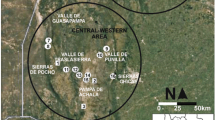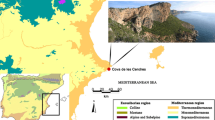Abstract
This paper presents new results from the Early Neolithic Dutch wetland site of Bergschenhoek (ca. 4200 cal b.c., Swifterbant Culture), which are compared with finds from similar features and sites. The data indicate the presence of predominantly eutrophic, nutrient-rich reed and forb vegetation and suggest the preparation of meals consisting of fish and fruits. The finds from the hearth, dominated by uncarbonised remains of wetland taxa, form a remarkable part of the find assemblage. Therefore, the discussion concerns assemblages, deposition processes and interpretations of uncarbonised and carbonised finds from hearths at comparable, contemporary sites. The wide variation of macroremains assemblages of hearths indicates that plant deposition in hearths is understood only partly and remains a topic for further research.


Similar content being viewed by others
References
Bakels CC (1991) Western Continental Europe. In: Van Zeist W, Wasylikowa K, Behre K-E (eds) Progress in Old World palaeoethnobotany. Balkema, Rotterdam, pp 279–298
Bakels CC, Van Beurden LM (2001) Archeobotanie. In: Louwe Kooijmans LP (ed) Archeologie in de Betuweroute. Hardinxveld-Giessendam Polderweg. (Rapp Archeol Monumentenzorg 83) ROB, Amersfoort, pp 325–378
Bakels CC, Van Beurden LM, Vernimmen TJJ (2001) Archeobotanie. In: Louwe Kooijmans LP (ed) Archeologie in de Betuweroute. Hardinxveld-Giessendam De Bruin. (Rapp Archeol Monumentenzorg 88) ROB, Amersfoort, pp 369–434
Bastiaens J, Deforce K, Klinck B, Meersschaert L, Verbruggen C, Vrydaghs L (2005) Palaeobotanical analyses. In: Crombé Ph (ed) The last hunter-gatherer-fisherman in sandy Flanders. (Archaeol Reports Ghent Univ 3) Academia Press, Ghent, pp 251–278
Beamish MG (2009) Island visits: Neolithic and Bronze Age activity on the Trent Valley floor. excavations at Egginton and Willington, Derbyshire, 1998–1999. Derbyshire Archaeol J 129:17–172
Behre K-E (2008) Collected seeds and fruits from herbs as prehistoric food. Veget Hist Archaeobot 17:65–73
Brinkkemper O, Hogestijn W-J, Peeters H, Visser D, Whitton C (1999) The Early Neolithic site at Hoge Vaart, Almere, the Netherlands, with particular reference to non-diffusion of crop plants, and the significance of site function and sample location. Veget Hist Archaeobot 8:79–86
Cappers RTJ (1993) Seed dispersal by water: a contribution to the interpretation of seed assemblages. Veget Hist Archaeobot 2:173–186
Clason AT, Brinkhuizen DC (1993) Bergschenhoek. In: Clason A, Payne S, Uerpmann H-P (eds) Skeletons in her cupboard. Festschrift for Juliet Clutton-Brock. (Oxbow Monogr 34) Oxbow, Oxford, pp 61–73
Crombé Ph (ed) (2005) The last hunter-gatherer-fishermen in sandy Flanders (NW Belgium). (Archaeol Reports Ghent Univ 3) Academia Press, Ghent
Dark P (2004) Plant remains as indicators of seasonality of site-use in the Mesolithic period. Environ Archaeol 9:39–45
Fuller DQ, Stevens C, McClatchie M (2012) Routine activities, tertiary refuse and labour organization: social inference from everyday archaeobotany. In: Madella M, Savard M, Lancelotti C (eds) Ancient plants and people. Contemporary trends in archaeobotany
Guiran AJ, Brinkkemper O in cooperation with Brinkhuizen DC, Klink A (2007) Rotterdam-Randstadrail: archaeologisch onderzoek 1 emplacement Centraal Station. (BOOR rapporten 318) Bureau Oudheidkundig Onderzoek, Rotterdam
Hogestijn JWH, Peeters JHM (eds) (2001) De mesolithische en vroeg-neolithische vindplaats Hoge Vaart-A27 (Flevoland). (Rapp Archeol Monumentenzorg 79) ROB, Amersfoort
http://www.pfaf.org/user/Plant.aspx?LatinName=Calystegia%20sepium Plants for a future. Accessed December 2010
Koot H, Bruning L, Houkes RA (eds) (2008) Ypenburg-locatie 4. Een nederzetting met grafveld uit het Midden-Neolithicum in het West-Nederlandse kustgebied. Hazenberg Archeologie, Leiden
Kubiak-Martens L (2006a) Roots, tubers and processed plant food in the local diet. In: Louwe Kooijmans LP, Jongste PFB (eds) Schipluiden. A Neolithic settlement on the Dutch North Sea Coast c. 3500 cal. b.c. (Analecta Praehist Leiden 37/38) University of Leiden, Leiden, pp 339–352
Kubiak-Martens L (2006b) Botanical remains and plant food subsistence. In: Louwe Kooijmans LP, Jongste PFB (eds) Schipluiden. A Neolithic settlement on the Dutch North Sea Coast c. 3500 cal. b.c. (Analecta Praehist Leiden 37/38) University of Leiden, Leiden, pp 317–338
Kubiak-Martens L (2008a) Wortels, knollen, en bereid plantaardig voedsel. In: Koot H, Bruning L, Houkes RA (eds) Ypenburg-locatie 4. Een nederzetting met grafveld uit het Midden-Neolithicum in het West-Nederlandse kustgebied. Hazenberg Archeologie, Leiden, pp 325–335
Kubiak-Martens L (2008b) Voedseleconomie: parenchym en andere plantaardige macroresten (Hanzelijn Oude Land—Knooppunt Hattemerbroek). BIAXiaal 386
Louwe Kooijmans LP (1985) Sporen in het land. Meulenhoff Informatief, Amsterdam
Louwe Kooijmans LP (1987) Neolithic settlement and subsistence in the wetlands of the Rhine/Meuse delta. In: Coles JM, Lawson AJ (eds) European wetlands in prehistory. Clarendon Press, Oxford, pp 227–251
Louwe Kooijmans LP (ed) (2001) Archeologie in de Betuweroute. Hardinxveld-Giessendam De Bruin. (Rapp Archeol Monumentenzorg 88) ROB, Amersfoort
Louwe Kooijmans LP (2007) The gradual transition to farming in the Lower Rhine Basin. Proc Brit Acad 144:287–309
Louwe Kooijmans LP, Jongste PFB (eds) (2006) Schipluiden. A Neolithic settlement on the Dutch North Sea Coast c. 3500 cal b.c. (Analecta Praehist Leiden 37/38) University of Leiden, Leiden
McClatchie M (2008) Analysis of non-wood plant macro-remains. Unpublished report Derragh, Co. Longford, Lake Settlement Project. Discovery Programme, Dublin
Mears R, Hillman G (2007) Wild food. Hodder and Stoughton, London
Mitchell GF (1972) Some Ultimate Larnian sites at Lake Derravaragh, Co.Westmeath. J R Soc Antiq Ireland 102:160–173
Monckton A (2007) Charred plant remains, Willington, Derbyshire. ALSF2517. http://ads.ahds.ac.uk/catalogue/resources.html?willington_eh_2008. Accessed December 2010
Monk MA, Pals JP (1985) Charred plant remains. In: Woodman PC (ed) Excavations at Mount Sandel 1973–1977. (Northern Ireland Archaeological Monographs 2) HMSO, Belfast, pp 79–81
Out WA (2008) Gathered food plants at Dutch Mesolithic and Neolithic wetland sites. In: Baker S, Allen M, Middle S, Poole K (eds) Conference proceedings food and drink in archaeology I: a postgraduate conference. Prospect Books, Totnes, pp 84–95
Out WA (2009) Sowing the seed? Human impact and plant subsistence at Late Mesolithic and Early and Middle Neolithic Dutch wetland sites (5500–3400 cal b.c.). (Archaeol Studies Leiden Univ 18) University Press, Leiden
Out WA (2010) Integrated archaeobotanical analysis: human impact at the Dutch Neolithic wetland site the Hazendonk. J Arch Sci 37:1,521–1,531
Perry D (1999) Vegetative tissues from Mesolithic sites in the northern Netherlands. Curr Anthropol 40:231–237
Peters FJC, Peeters JHM (2001) De opgraving van de Mesolithische en Neolithische vindplaats Urk-E4 (Domineesweg, gemeente Urk). (Rapp Archeol Monumentenzorg 93) ROB, Amersfoort
Regnell M, Gaillard M-J, Bartolin TS, Karsten P (1995) Reconstruction of environment and history of plant use during the late Mesolithic (Ertebølle culture) at the inland settlement of Bökeberg III, southern Sweden. Veget Hist Archaeobot 4:67–91
Robinson DE, Harild JA (2002) The archaeobotany of an Early Ertebølle (Late Mesolithic) site at Halsskov, Zealand, Denmark. In: Hather JG, Mason S (eds) Hunter-gatherer archaeobotany. Perspectives from the northern temperate zone. University College London, London, pp 84–95
Schaminée JHJ, Stortelder AHF, Weeda EJ (1996) De vegetatie van Nederland 3. Opulus Press, Leiden/Uppsala
Schaminée JHJ, Weeda EJ, Westhoff V (1998) De vegetatie van Nederland 4. Opulus Press, Leiden/Uppsala
Statistics Netherlands (2003) BioBase, register biodiversiteit. CBS, Voorburg
Van Beurden L (2008) Macroresten. In: Koot H, Bruning L, Houkes RA (eds) Ypenburg-locatie 4. Een nederzetting met grafveld uit het Midden-Neolithicum in het West-Nederlandse kustgebied. Hazenberg Archeologie, Leiden, pp 315–324
Van der Meijden R (2005) Heukels’ flora van Nederland, 23rd edn. Wolters-Noordhoff, Groningen
Visser D, Whitton C, Brinkkemper O, Hogestijn JWH (2001) Archeobotanie: de analyse van botanische macroresten. In: Hogestijn JWH, Peeters JHM (eds) De mesolithische en vroeg-neolithische vindplaats Hoge Vaart-A27 (Flevoland). (Rapp Archeol Monumentenzorg 79) ROB, Amersfoort
Weeda EJ, Westra R, Westra C, Westra T (1985–1994) Nederlandse Oecologische Flora. (Wilde planten en hun relaties 1–5) KNNV/IVN, Amsterdam
Weeda EJ, Westra R, Westra C, Westra T (1991) Nederlandse Oecologische Flora. (Wilde planten en hun relaties 4) KNNV/IVN, Amsterdam
Acknowledgments
The author would like to thank W. van Zeist for kindly making the data and context information available, L. P. Louwe Kooijmans, M. Schepers, K.-E. Behre, O. Brinkkemper and J. Greig for valuable discussion and suggestions, and R. T. J. Cappers, R. Palfenier-Vegter (Groningen Institute for Archaeology), I. L. M. Stuijts, C. Fredengren, L. Verhart, L. Amkreutz (Rijksmuseum van Oudheden) and the members of the Archaeobotany mailing list for their kind and valuable efforts. This paper is partly based on research carried out at the Faculty of Archaeology, Leiden University and funded by NWO (Netherlands Organisation for Scientific Research).
Author information
Authors and Affiliations
Corresponding author
Additional information
Communicated by K.-E. Behre.
Electronic supplementary material
Rights and permissions
About this article
Cite this article
Out, W.A. What’s in a hearth? Seeds and fruits from the Neolithic fishing and fowling camp at Bergschenhoek, The Netherlands, in a wider context. Veget Hist Archaeobot 21, 201–214 (2012). https://doi.org/10.1007/s00334-011-0338-7
Received:
Accepted:
Published:
Issue Date:
DOI: https://doi.org/10.1007/s00334-011-0338-7





